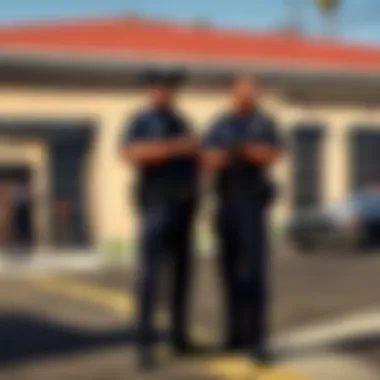Unveiling the Intricacies of the Carson Police Station: A Comprehensive Exploration


Key Milestones and Releases
Throughout its history, the GTA game series has seen several key milestones and releases that have left an indelible mark on the gaming world. From the groundbreaking debut of GTA III, which revolutionized open-world gameplay, to the sprawling metropolis of GTA V, which set new standards for immersion and scale, each installment has brought something unique to the table. With spin-offs, expansions, and online multiplayer modes adding to the series' legacy, GTA continues to be a powerhouse in the gaming industry, continually innovating and captivating players with its distinct blend of action, humor, and social commentary.
Introduction to the Carson Police Station
In delving into the Carson Police Station, we uncover a crucial bastion in law enforcement. Understanding the foundational principles and operational dynamics of this institution is paramount for grasping its significance within the community. The Carson Police Station stands as a cornerstone of safety and order, embodying a commitment to upholding justice and protecting its residents. By exploring its inner workings, we shed light on the intricate mechanisms that drive its mission forward.
Historical Background
The founding of the Carson Police Station
The establishment of the Carson Police Station marks a pivotal moment in the locality's security landscape. Through a detailed examination of its inception, we unravel the threads that bind its origins to present-day operations. The deliberate choices made during the founding phase laid the groundwork for the station's ethos and positioning within the broader law enforcement framework. Understanding the rationale behind its establishment provides valuable insights into the station's evolution over time.
Influence of historical events on its development
Historical events have intricately woven their influence into the fabric of the Carson Police Station's development. From mitigating past challenges to leveraging historical learnings, these events have shaped the station's approach to policing. By dissecting this historical tapestry, we glean a deeper understanding of how external forces have sculpted the station into what it is today, adapting to meet the evolving needs of the community.
Mission and Vision
Core objectives of the Carson Police Station
At the core of the Carson Police Station lie defined objectives that steer its daily operations. These objectives serve as guiding beacons, directing the actions and initiatives that uphold the station's mandate. By elucidating these core goals, we illuminate the priorities that drive the station's activities, fostering a safer environment for all. Examining the alignment of these objectives with community needs unveils the station's strategic focus on enhancing public safety.
Commitment to community safety
A steadfast commitment to community safety permeates the ethos of the Carson Police Station. This unwavering pledge underscores the station's role as not just a law enforcement entity but as a guardian of the community. By prioritizing the well-being of residents, the station cultivates trust and collaboration, essential ingredients for effective policing. Unpacking the various initiatives undertaken in the name of community safety reveals the station's proactive stance towards fostering a secure neighborhood.
Organizational Structure
Key departments within the Carson Police Station
Within the intricate framework of the Carson Police Station reside key departments vital to its seamless operation. These departments serve as specialized pillars, each contributing uniquely to the station's overarching goals. Exploring the functions and interplay of these departments unveils a harmonized structure designed to address diverse facets of law enforcement. By delineating the roles and responsibilities of each department, we gain a holistic view of the station's organizational prowess.
Roles and responsibilities of staff members
The effectiveness of the Carson Police Station hinges on the dedicated efforts of its staff members. Each individual within the station plays a pivotal role in advancing its mission and upholding its values. Delving into the specific responsibilities shouldered by these staff members illuminates the intricate web of collaboration necessary for operational success. By examining the interconnectivity of roles, we appreciate the collective effort required to maintain the station's operational excellence.
Operational Procedures
Operational Procedures play a vital role in the functioning of the Carson Police Station. These protocols are crucial for ensuring smooth and efficient daily operations within the facility. For law enforcement agencies, having clearly defined operational procedures is essential as it sets the standard for how tasks should be carried out. By outlining specific guidelines and steps to follow, Operational Procedures help minimize errors, ensure consistency in handling different situations, and enhance overall organizational efficiency.


Emergency Response Protocols
Dispatch procedures
Dispatch procedures are a cornerstone of Emergency Response Protocols at the Carson Police Station. They involve the timely and accurate deployment of resources in response to emergency calls. The efficiency of dispatch procedures directly impacts the effectiveness of emergency response efforts. One key characteristic of dispatch procedures is their ability to prioritize incoming calls based on the level of urgency, ensuring that critical situations receive immediate attention. The unique feature of automated dispatch systems enables quick allocation of resources, reducing response times and potentially saving lives.
Coordination with other emergency services
Effective Coordination with other emergency services is paramount for seamless operations at the Carson Police Station. This collaboration ensures a unified response to complex emergencies that require multi-agency involvement. Key characteristics of this coordination include clear communication channels, mutual aid agreements, and coordinated training exercises. By leveraging the expertise and resources of different emergency services, the Carson Police Station can enhance its overall emergency response capabilities. However, challenges such as jurisdictional issues and differing protocols between agencies may pose disadvantages to this collaborative approach.
Patrol and Surveillance
Utilization of technology for monitoring
The Carson Police Station embraces advanced technology for monitoring activities in its jurisdiction. By leveraging sophisticated surveillance systems and data analytics tools, law enforcement officers can gather real-time information and intelligence to support their patrol efforts. The key characteristic of technology-enabled monitoring is the ability to cover large areas efficiently and identify potential threats proactively. This approach is popular for its effectiveness in crime prevention and enhancing overall public safety. However, reliance on technology may present disadvantages such as cybersecurity vulnerabilities and the need for continuous training.
Community engagement initiatives
Community engagement initiatives form a critical component of the Carson Police Station's approach to policing. By actively involving residents in crime prevention efforts and fostering positive relationships, law enforcement officers can build trust and cooperation within the community. The key characteristic of such initiatives is their ability to create a shared sense of responsibility for public safety, leading to collaborative crime prevention strategies. Community engagement is a beneficial choice for this article as it highlights the importance of building strong ties with the community for effective policing. Despite its advantages in promoting transparency and trust, community engagement initiatives may face challenges such as resource constraints and varying community expectations.
Investigative Techniques
Forensic capabilities
The Carson Police Station prides itself on its advanced forensic capabilities, which are instrumental in solving complex criminal cases. By utilizing state-of-the-art forensic tools and techniques, law enforcement specialists can analyze and interpret physical evidence to reconstruct events and identify perpetrators. The key characteristic of forensic capabilities is their precision and scientific approach to crime scene investigation, aiding in securing convictions and delivering justice. This aspect is a popular choice for this article due to its significance in modern law enforcement practices. However, the disadvantages of relying heavily on forensic evidence include the potential for contamination and the need for specialized training.
Collaboration with specialized units
Collaboration with specialized units enhances the investigative prowess of the Carson Police Station. By partnering with units such as SWAT teams, cybercrime divisions, and forensic experts, law enforcement agencies can pool their expertise to tackle complex criminal activities effectively. The key characteristic of such collaborations is the synergy created by bringing together diverse skill sets and resources to achieve common investigative goals. This collaborative approach is a beneficial choice for this article as it underscores the importance of inter-agency cooperation in addressing contemporary crimes. While collaboration offers advantages like resource optimization and enhanced capabilities, challenges such as information sharing barriers and conflicting priorities may arise.
Technological Advancements
In the realm of law enforcement, technological advancements play a pivotal role in enhancing efficiency and effectiveness. The Carson Police Station embraces cutting-edge technology to streamline operations and address modern-day challenges. These advancements not only improve data management but also aid in surveillance, communication, and crime prevention.
Data Analysis Tools
Predictive Analytics for Crime Prevention
Predictive analytics stands out as a cornerstone in the arsenal of modern policing techniques. By analyzing past data and patterns, law enforcement agencies can anticipate potential crime hotspots and take proactive measures to prevent incidents. In the context of the Carson Police Station, predictive analytics serves as a proactive tool to allocate resources strategically and deploy officers effectively. The predictive power of this tool allows law enforcement to stay ahead of criminal activities, leading to a more secure community. While its advantages are evident in crime prevention, challenges such as data accuracy and interpretation complexity require continuous refinement.
Digital Evidence Management Systems
Digital evidence management systems revolutionize the handling of evidence in criminal investigations. These systems provide a centralized platform for storing, organizing, and analyzing digital evidence, simplifying the investigative process. Within the Carson Police Station, the implementation of digital evidence management systems ensures seamless integration of multimedia evidence, leading to efficient case resolutions. Despite offering enhanced accessibility and retrieval speed, challenges related to data security and privacy concerns necessitate stringent protocols and continuous monitoring.


Surveillance Innovations
Use of Drones for Aerial Monitoring
The utilization of drones for aerial monitoring offers the Carson Police Station unparalleled surveillance capabilities. Drones provide real-time aerial views of crime scenes, traffic conditions, and large-scale events, enabling quick response and data gathering. This innovative approach enhances situational awareness and enhances operational efficiency, especially in scenarios where traditional surveillance methods fall short. While drones present opportunities for cost-effective and expansive monitoring, issues such as regulatory compliance and public perception require careful consideration and adherence.
Body-Worn Cameras for Transparency
Body-worn cameras have emerged as a tool for transparency and accountability within law enforcement agencies. These cameras capture audio-visual evidence from the officer's perspective, providing an unbiased record of interactions and incidents. At the Carson Police Station, the adoption of body-worn cameras ensures enhanced trust between officers and the community, fostering accountability and transparency. Despite their benefits in evidence collection and officer training, challenges such as data storage and privacy concerns necessitate robust policies and regulations.
Communication Infrastructure
Integration of Radio Systems
The integration of radio systems serves as a fundamental component of communication within the Carson Police Station. Radio systems enable seamless and instant communication between officers, dispatchers, and other emergency services, ensuring efficient coordination during critical situations. This integration enhances response times, operational coordination, and overall effectiveness in managing emergencies. While radio systems offer reliability and broad coverage, factors like signal interference and channel congestion demand ongoing maintenance and technological updates.
Mobile Data Terminals for Real-Time Updates
Mobile data terminals empower officers at the Carson Police Station with access to real-time information, enhancing situational awareness and decision-making capabilities. These terminals provide critical data on suspects, vehicles, and incidents, improving officer safety and operational efficiency. By enabling officers to access databases and receive updates while in the field, mobile data terminals ensure swift and informed responses to evolving situations. Despite the advantages of increased connectivity and information accessibility, challenges like cybersecurity threats and data reliability necessitate stringent security protocols and continuous training.
Community Engagement
Community engagement holds immense importance in shedding light on the Carson Police Station's interaction with the public. Understanding the intricacies of community engagement is crucial as it encapsulates the station's efforts to build trust and collaborative relationships with residents. By delving into various community engagement facets, including outreach programs, feedback mechanisms, and partnerships, readers gain a profound insight into the station's dedication to fostering a safe and supportive environment for all involved.
Outreach Programs
Community Policing Initiatives
Community policing initiatives are pivotal components of the Carson Police Station's strategy to proactively address community concerns. The emphasis on community involvement and problem-solving distinguishes this approach, making it a strategic ally in the station's community relations. This method's key characteristic lies in its emphasis on forming partnerships between law enforcement and the community, promoting mutual understanding and shared responsibility for public safety. The unique feature of community policing initiatives pertains to its ability to bridge the gap between law enforcement and civilians, resulting in enhanced trust and cooperation. However, challenges such as resource constraints or varying community perceptions may impact its efficacy within the station's operations.
Youth Mentorship Programs
Youth mentorship programs play a vital role in the Carson Police Station's outreach initiatives by engaging with the younger population. These programs offer guidance, support, and positive role models to help shape the future of the community. The key characteristic of youth mentorship programs is the focus on youth development, aiming to empower and educate the next generation. Their unique feature lies in creating a platform for constructive dialogue and understanding between youth and law enforcement, fostering positive relationships and preventing delinquent behaviors. While beneficial, potential challenges such as scalability or sustained engagement may present themselves in executing youth mentorship programs successfully within the station.
Feedback Mechanisms
Citizen Feedback Channels
Citizen feedback channels provide an invaluable avenue for residents to voice their opinions, report concerns, and contribute to the station's ongoing improvement efforts. The Carson Police Station prioritizes these channels to gather community feedback, address issues promptly, and enhance overall service delivery. The key characteristic of citizen feedback channels is their role in promoting transparency and accountability within the station's operations. Their unique feature lies in fostering a culture of open communication and responsiveness between law enforcement and the public, helping build trust and mutual respect. However, challenges such as ensuring the inclusivity of feedback or managing varying expectations may emerge in effectively utilizing citizen feedback channels.
Surveys for Continuous Improvement


Implementing surveys for continuous improvement enables the Carson Police Station to collect structured data, measure performance, and identify areas for enhancement. These surveys serve as valuable tools for soliciting detailed feedback from the community, enabling the station to adapt its strategies based on concrete input. The key characteristic of surveys for continuous improvement is their role in driving evidence-based decision-making and strategic planning within the station. Their unique feature lies in providing quantitative insights that supplement qualitative feedback, offering a comprehensive understanding of community perceptions and needs. However, challenges such as survey fatigue or interpretation of survey results may pose obstacles in leveraging surveys effectively for continuous improvement within the station.
Partnerships and Collaborations
Joint Operations with Other Law Enforcement Agencies
Collaborating on joint operations with other law enforcement agencies is a strategic move by the Carson Police Station to pool resources, expertise, and capabilities in tackling complex challenges. These operations foster interagency cooperation, streamline information sharing, and maximize the collective impact on crime prevention and enforcement. The key characteristic of joint operations lies in their ability to harness synergies between diverse agencies, leading to a more coordinated and efficient approach to law enforcement. Their unique feature encompasses the diversity of skills and resources brought together, enabling a multidimensional response to complex security threats. However, challenges such as interagency communication or coordination issues may arise in executing joint operations effectively within the station.
Collaborations with Non-Profit Organizations
Engaging in collaborations with non-profit organizations augments the Carson Police Station's community outreach by leveraging external resources, expertise, and networks. These collaborations facilitate innovative solutions, support community programs, and address social issues beyond the station's traditional scope of operations. The key characteristic of collaborations with non-profit organizations is their mutual goal of serving the community's best interests through shared projects and initiatives. Their unique feature lies in the diversity of perspectives and skills brought by the non-profit sector, enriching the station's approach to community engagement and problem-solving. However, challenges such as aligning organizational priorities or sustaining long-term partnerships may require careful management to ensure fruitful collaborations within the station.
Challenges and Future Outlook
In this section, we delve into the critical aspects of challenges and future outlook concerning the Carson Police Station. Understanding the challenges and projecting future directions is imperative for the continued effectiveness of law enforcement operations. By analyzing the prevailing obstacles and envisioning the forthcoming strategies, the article aims to provide a holistic view of the agency's trajectory.
Resource Allocation Issues
Budget constraints impact operations
The budget constraints affecting operations at the Carson Police Station are a fundamental concern that resonates throughout the organization. The limitation in financial resources directly influences the capacity to maintain adequate staffing levels, procure essential equipment, and implement necessary training programs. Tight budgetary conditions pose challenges in upgrading technological infrastructures and impede the efficiency of crime prevention initiatives. However, these constraints also spur innovation and strategic resource management, driving the agency to explore cost-effective solutions and prioritize critical expenditures.
Need for increased staffing levels
The necessity for bolstering staffing levels within the Carson Police Station stems from the escalating demands of a dynamic community landscape. Adequate manpower is pivotal in ensuring prompt emergency response, conducting thorough investigations, and sustaining proactive community engagement programs. The shortage of personnel hinders operational capabilities, leading to fatigue among existing staff and compromising overall service quality. By addressing the need for increased staffing, the agency can enhance public safety measures, optimize resource utilization, and fortify collaborative efforts with external stakeholders.
Adapting to Technological Changes
Embracing technological advancements is paramount for the Carson Police Station to remain at the forefront of law enforcement practices. Efforts to adapt to evolving technological landscapes signify a commitment to enhancing operational efficiencies, optimizing data-driven decision-making processes, and integrating innovative solutions for crime prevention. Leveraging training programs for new technologies equips personnel with the requisite skills to leverage cutting-edge tools effectively. Similarly, the integration of artificial intelligence (AI) in policing operations revolutionizes investigative processes, augments surveillance capabilities, and enables predictive analytics for proactive law enforcement measures.
Training programs for new technologies
The incorporation of training programs for new technologies is instrumental in empowering personnel with the knowledge and skills required to navigate complex digital systems. By offering comprehensive training modules on emerging tools and software applications, the Carson Police Station can foster a tech-savvy workforce capable of leveraging advanced resources for operational optimization. These programs not only enhance organizational proficiency but also cultivate a culture of continuous learning and adaptability among staff members.
Integration of AI in policing
The integration of artificial intelligence (AI) in policing operations signifies a paradigm shift towards data-driven law enforcement methodologies. AI algorithms enable the automated analysis of vast datasets, facilitate predictive modeling for crime trends, and streamline resource allocation for enhanced risk assessment. Incorporating AI solutions enhances the efficacy of investigative techniques, augments surveillance capabilities, and enables proactive intervention strategies based on real-time insights.
Community Perception and Trust
Building and maintaining positive relationships with the community is a cornerstone of effective policing strategies. The Carson Police Station's commitment to transparency, accountability, and proactive community engagement fosters trust, enhances public cooperation, and cultivates mutual respect between law enforcement authorities and residents. By prioritizing community-oriented initiatives and implementing structured feedback mechanisms, the agency can gain invaluable insights, address concerns proactively, and reinforce its role as a guardian of public safety.
Building positive relationships with residents
Establishing positive relationships with residents is pivotal in nurturing a safe and inclusive community environment. By promoting open dialogues, organizing community events, and actively participating in outreach programs, the Carson Police Station can bridge socio-cultural divides, dispel mistrust, and foster collaborative partnerships with local stakeholders. Building rapport with residents not only strengthens social cohesion but also facilitates efficient information sharing and joint problem-solving efforts, promoting a collective approach to crime prevention and public safety.
Transparency and accountability measures
Transparency and accountability measures form the bedrock of public trust in law enforcement agencies. Upholding stringent accountability standards, implementing transparent investigation protocols, and ensuring ethical conduct in all interactions reinforce the legitimacy and credibility of the Carson Police Station. By embracing transparency as a guiding principle, the agency promotes community confidence, encourages civic participation in crime prevention initiatives, and paves the way for constructive partnerships with diverse community segments.



